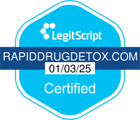Alfenta Detox
Rapid Drug Detox can help detox you from Alfenta, also known as Alfentanil.
Alfenta Addiction
Alfenta is an opioid analgesic derived from fentanyl that has a rapid onset and short duration. It is used for moderate to severe pain relief before or during surgery. Alfenta is given by vein – either slow IV injection or continuous infusion.
Call us at 1-866-399-2967 or just contact us to learn more about how we can help you overcome Alfenta addiction.
Alfenta Addiction Effects
Alfenta, like all opioids, has a potential for abuse. Side effects include dizziness, drowsiness, nausea, vomiting, and itching etc.
Alfenta Withdrawal Symptoms
Alfenta withdrawal can be a painful process, particularly after heavy use. Symptoms are typically experienced within hours of stopping the use and can last up to several weeks, depending on the intensity of Alfenta use. Symptoms of Alfenta withdrawal include: sweating, anxiety, depression, yawning, nausea, vomiting, diarrhea, cramps, and fever. Other symptoms of withdrawal include: body aches in the bone and muscle, muscle cramping, leg kicking, back ache, runny nose, watery eyes, sneezing, goose bump cool, pale and clammy skin, strong irritability, chills, abdominal cramps, weakness, convulsions, dehydration, insomnia, thoughts of suicide. All of these symptoms can be quite pronounced causing the patient to experience such intense pain and suffering that a “cold turkey” withdrawal is unbearable, causing the patient to continue their drug use.
Rapid Anesthesia Alfenta Detox
The RDD Method™ for Alfenta detoxification under anesthesia is a medical procedure that eliminates most of the withdrawal symptoms. During the procedure the patient is given medication to relax and then put under light, general anesthesia for approximately 60 minutes. Following the procedure, recovery begins under direct medical supervision.
The patient’s vital signs and overall physical and mental reactions to these medications are closely monitored during the detox procedure. In the days that follow, the patient often sleeps more than usual. Administered by professionals as part of a long-term drug-addiction recovery strategy, The RDD Method™ is significantly more effective than other courses of Alfenta addiction treatment.
Alfenta Addiction FAQs
- How do I know if I am addicted to Alfenta?
A.Short-term users may require a detox program in order to successfully discontinue use of the drug, because of Alfenta’s addictive traits. Addicts typically require higher doses of the drug and experience cravings for Alfenta between doses. - How long does Alfenta detox take?
A.The detox process for Alfenta varies in length depending on the pattern of typical use and on individual differences. The most severe withdrawal symptoms occur during the first several days after discontinuing use of the drug, making it important to seek immediate professional help from trained Alfenta-detox professionals. - Is Alfenta-addiction recovery painful?
A.While recovery from Alfenta addiction can be painful; the right procedure greatly reduces discomfort. Anesthesia Alfenta detox is a procedure that is effective at reducing the pain normally associated with Alfenta detox. - How do I choose a Alfenta-detox program?
A.Talking to a trained detox or medical professional is the right first step in choosing the appropriate program. Call us at 1-866-399-2967 or contact us to learn more.
If you are using opiate drugs to control pain and feel you are using more and more to get the same pain relief, you may be suffering from a common condition caused from opiate drug use; read about this condition called Hyperalgesia. Also, read about hormones and how the chronic use of opiate drugs can decrease the body’s ability to produce the proper amount of testosterone and estrogen.
We never use other replacement addicting opiates, often prescribed by physicians and detox centers, such as Suboxone®/Subutex (Buprenorphine) or injectable Buprenorphine. These schedule III controlled opiate drugs are routinely and widely used and approved by the FDA for opiate addiction maintenance, like Methadone. Many patients find themselves in the same situation as they were before drug treatment from a doctor or a drug rehabilitation center. Some in-patient rehab centers also use schedule II controlled liquid Hydrocodone and Dilaudid “cocktails”. Patients soon realize these replacement drugs cause severe withdrawal once they are discharged from these programs. This causes the patient to seek opiates for relief from the severe discomfort of a Buprenorphine withdrawal. The use of these drugs for treatment of opiate addiction is merely switching one opiate drug for another setting the patient up for failure. This does not solve the patient’s drug addiction problem. As use of these drugs become more common, we are seeing a steady increase of requests for an anesthesia detox from patients addicted to Suboxone®/Subutex (Buprenorphine). With RDD’s Naltrexone Therapy used as a pellet/implant, injectable “IM” shot or the oral pill form, the patient stays clean and cravings are eliminated.


